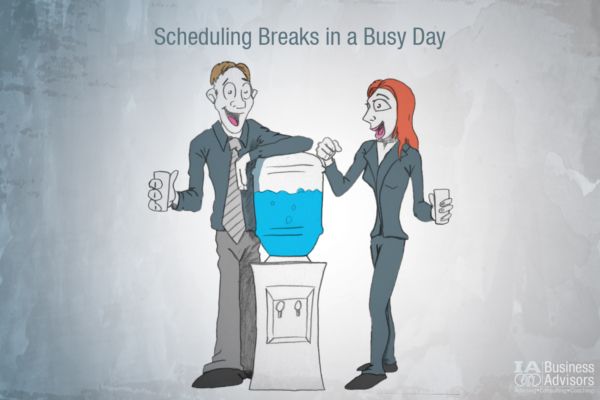Scheduling Breaks in a Busy Day

Effective business consulting strategies
Breaks throughout the work day are vital to all individual and team success. All individuals should aim to schedule one brain break every hour, or one brain break between every task, so that they can revamp and apply their best self to their next task.
Benefits of Breaks
Productivity Increase
It may seem counterproductive to take breaks throughout the day, but scheduling breaks actually increases your productivity. When you force your brain to focus without breaks for eight plus hours a day, your brain will eventually tire. Breaks allow your brain a little bit of time to revamp itself and prepare for the next task ahead. This makes you more productive because if you let your brain exhaust without breaks, it will take you longer to complete tasks closer to the end of your day. Also, breaks allow you to complete tasks more accurately, leaving less room for errors.
Reduces Stress
Stress can stem from many situations when you are at work; giving yourself some brain breaks can help ward off that stress. You can only take in so much information before your brain feels “overloaded” which can trigger cortisol (the stress hormone). Stress can lead to a number of issues such as fatigue, hopelessness, irritability, and other negative behaviors. You owe it to yourself and your team to keep your brain as stress-free as possible, so you can continue with your best influence.
Good for the Body
Taking breaks helps your mind and body perform at their optimal self. If you work in front of a computer all day, it’s important for your eyes to take a break from staring at your screens. Staring at screens for prolonged periods of time can lead to headaches, dry eyes, blurred vision, difficulty focusing, and all-around eye discomfort. Getting up and moving a bit during your breaks can help your circulation and muscles stretch out.
Productive Break Ideas
Here are some break ideas that you start applying to your work day, now:
Walk, Stretch, or Exercise
Physical breaks are important for your bodily and mental health. These types of breaks for individuals who find themselves sitting at a desk for eight hours a day will help ward off the risks of heart disease, diabetes, depression, and obesity. You can just get up from your chair, do a little walk to the water cooler or outside if it’s a nice day, stretch/yoga, or any other short physical activity you can perform in the comfort of your office. Even just a five-minute break every hour can significantly improve your health and well-being.
Change of Environment
You may decide that a good break for you entails moving your work to another location. Sometimes getting a change of scenery is enough for your brain to take a break and switch gears. You can go anywhere that has free Wi-Fi: libraries, coffee shops, restaurants, hotels, malls, and more.
Take Your Lunch/Snack Break
It’s important to keep your body well fed with wholesome, good foods throughout your entire day. This ensures your body gets the nutrients it needs to feed your brain, and you get a break. This way, you can feed two birds with one scone! (Pun intended.)
Meditate
You can either meditate, try alternate nostril breathing, or take a few deep breaths on your break to center yourself and your mind. Check out the link above to learn about the benefits of alternate nostril breathing and how to do it.
When Not to Break
Given our information above, sometimes it’s not the best time to take a break, even if you have scheduled it already. You may find yourself working and in a good groove; if you notice this, it may not be the best idea to interrupt your groove and lose your train of thought. Instead, you should finish the task you have at hand and take a break immediately after. You can always rearrange your schedule a bit and improvise.
Breaks are a win-win situation for every team (employers and employees). It boosts employee morale, productivity, and all-around company culture. It’s important to not push yourself or your employees past their limits to where they can no longer perform at their optimal self. Everyone deserves to recharge their brain so that they can bring their best influence to their team and tasks. Make sure you are scheduling brain breaks throughout your day and remain flexible.












